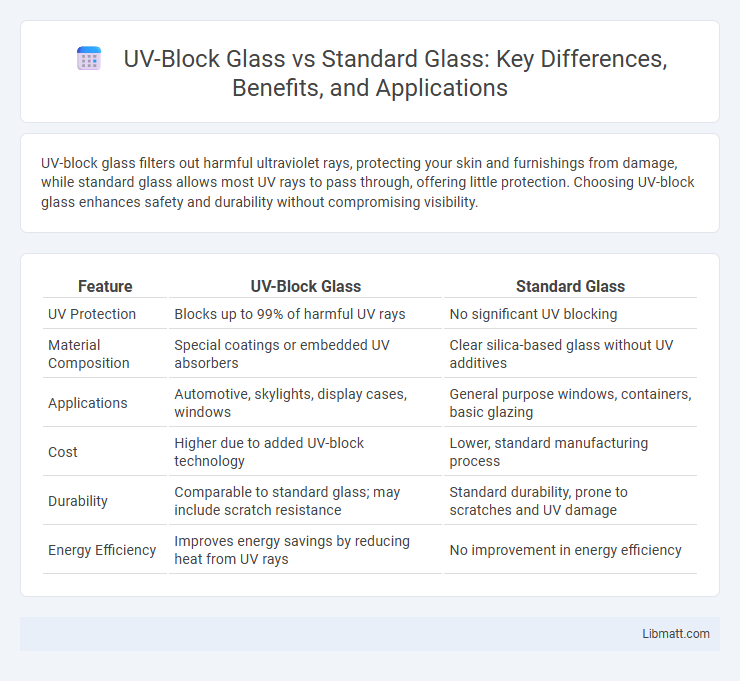UV-block glass filters out harmful ultraviolet rays, protecting your skin and furnishings from damage, while standard glass allows most UV rays to pass through, offering little protection. Choosing UV-block glass enhances safety and durability without compromising visibility.
Table of Comparison
| Feature | UV-Block Glass | Standard Glass |
|---|---|---|
| UV Protection | Blocks up to 99% of harmful UV rays | No significant UV blocking |
| Material Composition | Special coatings or embedded UV absorbers | Clear silica-based glass without UV additives |
| Applications | Automotive, skylights, display cases, windows | General purpose windows, containers, basic glazing |
| Cost | Higher due to added UV-block technology | Lower, standard manufacturing process |
| Durability | Comparable to standard glass; may include scratch resistance | Standard durability, prone to scratches and UV damage |
| Energy Efficiency | Improves energy savings by reducing heat from UV rays | No improvement in energy efficiency |
Understanding UV-Block Glass: Key Features
UV-block glass is engineered with special coatings or additives that effectively filter out harmful ultraviolet rays, protecting interiors from fading and damage. Unlike standard glass, which allows most UV light to penetrate, UV-block glass enhances energy efficiency by reducing heat buildup and safeguarding skin from UV exposure. Your choice of UV-block glass ensures improved durability and comfort, making it ideal for residential and commercial applications.
Standard Glass: Composition and Limitations
Standard glass primarily consists of silica (silicon dioxide), soda ash, and limestone, offering basic transparency and structural integrity but limited UV protection. Its composition allows visible light to pass through while permitting up to 85% of harmful ultraviolet (UV) rays, which can cause fading of interior furnishings and skin damage. The lack of UV-blocking additives or coatings makes standard glass less effective in environments requiring enhanced UV protection.
How UV-Block Glass Works
UV-block glass uses a special coating or laminated layer embedded with UV-absorbing materials that filter out harmful ultraviolet rays from sunlight, preventing them from passing through the glass. Unlike standard glass, which allows most UV radiation to penetrate, UV-block glass protects your interiors from fading, damage, and skin exposure to UV rays. This innovative glass technology enhances comfort and durability by maintaining natural light while effectively reducing harmful UV exposure.
UV Protection: Comparing Effectiveness
UV-block glass offers superior UV protection by filtering out up to 99% of harmful ultraviolet rays, significantly reducing the risk of skin damage and fading of interior furnishings. Standard glass typically blocks only about 25-30% of UV rays, allowing more harmful radiation to pass through. Choosing UV-block glass enhances Your indoor safety and preserves the longevity of your belongings by minimizing UV exposure.
Applications of UV-Block Glass
UV-block glass is primarily used in museums, galleries, and retail displays to protect sensitive artifacts, artwork, and merchandise from harmful ultraviolet light that causes fading and deterioration. It is also commonly utilized in automotive windows and residential buildings to reduce UV exposure, enhancing occupant comfort and preventing interior damage. In medical and laboratory settings, UV-block glass safeguards instruments and materials that are vulnerable to UV-induced degradation.
Energy Efficiency: UV-Block vs Standard Glass
UV-block glass significantly improves energy efficiency by filtering out up to 99% of harmful ultraviolet rays, reducing heat transfer and minimizing cooling costs compared to standard glass. This advanced glazing technology helps maintain your indoor temperature, lowering reliance on air conditioning and enhancing overall comfort. Choosing UV-block glass contributes to long-term energy savings and environmental sustainability by reducing energy consumption.
Impact on Interior Fading and Material Protection
UV-block glass significantly reduces interior fading by filtering out up to 99% of harmful ultraviolet rays, which are primary contributors to the deterioration of fabrics, upholstery, and artwork. Standard glass allows most UV rays to penetrate, accelerating color fading and material degradation over time. Your choice of UV-block glass enhances the longevity and appearance of interior furnishings, preserving their value and aesthetic appeal.
Cost Differences Between UV-Block and Standard Glass
UV-block glass typically costs 15% to 30% more than standard glass due to specialized coatings that filter harmful ultraviolet rays. The price variance depends on factors such as glass thickness, size, and coating technology, with advanced UV-block options sometimes commanding a premium of up to 40%. Despite higher upfront costs, UV-block glass contributes to long-term savings by reducing fading of interior furnishings and lowering cooling energy expenses.
Installation and Maintenance Considerations
UV-block glass requires careful installation to ensure the protective coatings remain intact, often involving specialized tools and techniques different from standard glass. Maintenance for UV-block glass includes using non-abrasive cleaners to preserve its UV filtering properties, whereas standard glass can tolerate a broader range of cleaning methods. You will benefit from reduced fading of interior furnishings and longer glass lifespan with proper handling and upkeep of UV-block glass.
Choosing the Right Glass for Your Needs
UV-block glass offers superior protection by filtering out up to 99% of harmful ultraviolet rays, making it ideal for preserving interior furnishings and preventing skin damage. Standard glass typically allows most UV radiation to pass through, which can lead to faster fading of fabrics and increased health risks over time. Selecting UV-block glass enhances durability and safety, particularly in environments exposed to intense sunlight or for users prioritizing long-term protection.
UV-block glass vs standard glass Infographic

 libmatt.com
libmatt.com